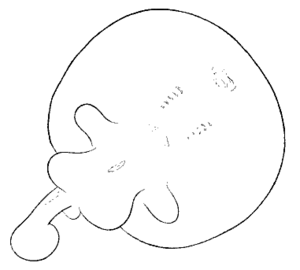Blind electric ray facts for kids
Quick facts for kids Blind electric ray |
|
|---|---|
 |
|
| Conservation status | |
| Scientific classification | |
| Synonyms | |
|
Astrape aysoni A. Hamilton, 1902 |
The blind electric ray (Typhlonarke aysoni) is a unique type of ray that lives in the ocean. It's a species of sleeper ray found only around New Zealand. This ray lives on the seafloor, usually very deep, about 300 to 400 meters (980 to 1,310 feet) down.
It can grow up to 38 centimeters (15 inches) long. This ray has a thin, almost round body that looks like a disc. Its eyes are hidden under its skin, so you can't see them! It has a short tail with one dorsal fin. Its pelvic fins are special, split into two parts. The front part acts like a small leg or limb.
The blind electric ray isn't a strong swimmer. It probably "walks" or pushes itself along the bottom using these special pelvic fins. It eats polychaete worms. Like other electric rays, it can give an electric shock to defend itself. Baby rays grow inside the mother without a placenta, which is called aplacental viviparous reproduction. Scientists don't have enough information to know if this species is endangered.
Contents
Discovering the Blind Electric Ray
The first blind electric ray was found by a fishing boat called Doto. This happened during a research trip in early 1900 in the Foveaux Strait. Lake F. Ayson, who led the trip, gave the ray to Augustus Hamilton. Hamilton worked at the Dominion Museum in New Zealand.
Hamilton named the ray Astrape aysoni to honor Lake F. Ayson. He wrote about this new species in a science journal in 1902. Later, in 1909, another scientist named Edgar R. Waite created a new group, or genus, called Typhlonarke for this ray. Sometimes, people also call it the blind legged torpedo or the round electric ray.
Where It Lives and Its Home
It's a bit tricky to know exactly where the blind electric ray lives. This is because it can be confused with another ray, the oval electric ray. Both species are found off the eastern coast of New Zealand. Their home stretches from the East Cape of North Island down to the Snares Shelf. This area includes the Cook and Foveaux Straits, and the Stewart and Chatham Islands.
This ray is a bottom-dwelling creature. This means it lives on or near the seafloor. It usually lives at depths between 300 and 400 meters (980 to 1,310 feet). However, some have been found as shallow as 46 meters (150 feet) and as deep as 800 meters (2,620 feet).
What the Blind Electric Ray Looks Like
The blind electric ray has a body that's almost perfectly round. This round part, called the pectoral fin disc, makes up about 70% of its total length. The edges of this disc are quite thin.
Its tiny eyes are hidden under its skin. You can't see them from the outside. They are only 1 to 2 millimeters (0.04 to 0.08 inches) below the surface. Small white spots show where the eyes are located. Behind the eyes are oval openings called spiracles. These have raised, smooth edges.
The ray's nostrils are close together. Their outer edges curl up to form almost complete tubes. The inner edges are larger and joined together. They form a fleshy curtain that almost reaches the mouth. The mouth itself is small and set back. Its teeth are arranged in a special pattern, forming narrow plates only at the front of the jaws. There are 10 to 12 rows of teeth in each jaw. The teeth inside are sharp, while the outer ones are flatter. It also has five pairs of short, curved gill slits.
The front part of each pelvic fin is shaped like a wide paddle. The back part of the pelvic fins blends smoothly with the pectoral fins, becoming part of the disc. There's a small dip where these fins meet the tail. Adult male rays have small, flat claspers. These do not stick out past the edge of the disc.
The ray has one dorsal fin that is shaped like a rectangle. It has a rounded back edge and starts above the back of the pelvic fins. The tail is short and thick. It has faint skin folds along its sides. The tail ends in a nearly round caudal fin that is slightly longer than it is tall. The skin of this ray is completely smooth. It doesn't have any dermal denticles, which are like tiny scales.
The blind electric ray is usually brown on top. It gets darker towards the tail. Its underside is beige. The undersides of its pelvic fin "legs" are almost white. Most blind electric rays are no longer than 38 centimeters (15 inches). However, there is an old story about one that might have been over 1.1 meters (3.6 feet) long!
How It Lives and What It Does
The blind electric ray has soft muscles and a small tail. This means it can't swim very well. Instead, scientists think it "walks" along the seafloor. It uses its movable pelvic fin "legs" to push itself along.
This ray is a blind predator. It probably sucks up its food. We know it eats polychaete worms. Like other electric rays, it has two kidney-shaped electric organs. These are located next to its head. These organs let it create an electric shock to protect itself. Each electric organ has 180 to 200 large, fluid-filled columns. These columns act like batteries connected together.
A type of tapeworm called Pentaloculum macrocephalum is known to live on this ray as a parasite. The blind electric ray gives birth to live young. Females can have up to 11 babies at a time. The newborns are about 9 to 10 centimeters (3.5 to 3.9 inches) long.
Humans and the Blind Electric Ray
The blind electric ray can sometimes get caught in bottom trawl nets. These nets are used by commercial fisheries. This might be a threat to the ray in the areas where it lives. However, there isn't enough specific information about this.
Because of the lack of data, the International Union for Conservation of Nature (IUCN) has listed it as Data Deficient. This means they don't have enough information to properly assess its conservation status. In June 2018, the New Zealand Department of Conservation said the blind electric ray was "Not Threatened." But they added the note "Data Poor," meaning they still need more information.
Images for kids



